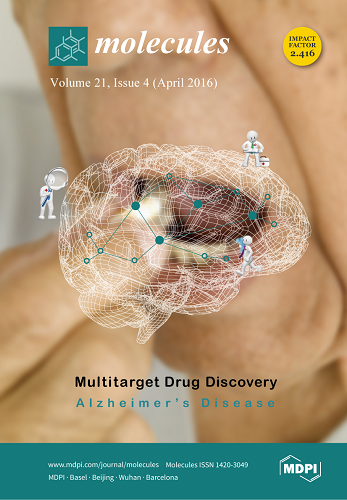We report single crystal X-ray diffraction (hereafter, SCXRD) analyses of derivatives featuring the electron-donor
N-ethylcarbazole or the (4-diphenylamino)phenyl moieties associated with a -CN group attached to a double bond. The compounds are (
2Z)-3-(4-(diphenylamino)-phenyl)-2-(pyridin-3-yl)prop-2-enenitrile (
I), (2
Z)-3-(4-(diphenylamino)phenyl)-2-(pyridin-4-yl)-prop-2-enenitrile (
[...] Read more.
We report single crystal X-ray diffraction (hereafter, SCXRD) analyses of derivatives featuring the electron-donor
N-ethylcarbazole or the (4-diphenylamino)phenyl moieties associated with a -CN group attached to a double bond. The compounds are (
2Z)-3-(4-(diphenylamino)-phenyl)-2-(pyridin-3-yl)prop-2-enenitrile (
I), (2
Z)-3-(4-(diphenylamino)phenyl)-2-(pyridin-4-yl)-prop-2-enenitrile (
II) and (
2Z)-3-(9-ethyl-9
H-carbazol-3-yl)-2-(pyridin-2-yl)enenitrile (
III). SCXRD analyses reveal that
I and
III crystallize in the monoclinic space groups
P2/c with
Z’ = 2 and
C2/c with
Z’ = 1, respectively. Compound
II crystallized in the orthorhombic space group
Pbcn with
Z’ = 1. The molecular packing analysis was conducted to examine the pyridine core effect, depending on the
ortho,
meta- and
para-positions of the nitrogen atom, with respect to the optical properties and number of independent molecules (
Z’). It is found that the double bond bearing a diphenylamino moiety introduced properties to exhibit a strong π-π-interaction in the solid state. The compounds were examined to evaluate the effects of solvent polarity, the role of the molecular structure, and the molecular interactions on their self-assembly behaviors. Compound
I crystallized with a cell with two conformers,
anti and
syn, due to interaction with solvent. DFT calculations indicated the
anti and
syn structures of I are energetically stable (less than 1 eV). Also electrochemical and photophysical properties of the compounds were investigated, as well as the determination of optimization calculations in gas and different solvent (chloroform, cyclohexane, methanol, ethanol, tetrahydrofuran, dichloromethane and dimethyl sulfoxide) in the Gaussian09 program. The effect of solvent by PCM method was also investigated. The frontier HOMO and LUMO energies and gap energies are reported.
Full article






